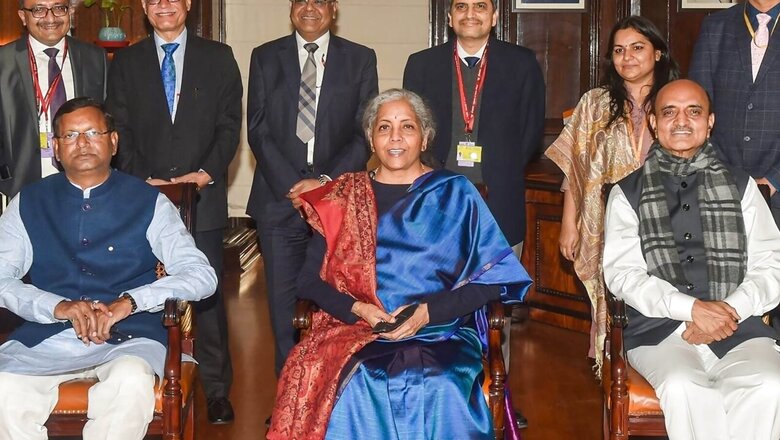
views
Union finance minister Nirmala Sitharaman is likely to strike a fine balance between being fiscally prudent and growth supportive when she presents her fourth straight Budget on Tuesday, which is expected to have plans to boost spending to revive investment, create jobs, bolster public healthcare, shore up micro, small and medium enterprises (MSMEs), and put the economy firmly on the path of recovery after a battering from the Covid pandemic.
Live Updates: Budget 2022 LIVE Updates: Will FM Listen to your Mann Ki Baat and Rejig Income Tax Slab?
The Budget comes just days before the first phase of voting on February 10 in Uttar Pradesh, which along with four other states is going to the polls, and so is expected to contain measures for higher rural and agriculture spending.
Asia’s third-largest economy is estimated to expand 9.2 per cent in the fiscal year that ends in March, following a contraction of 7.3 per cent in the previous fiscal.
The Budget for the fiscal year starting April 1, 2022, is likely to raise spending on infrastructure to set the economy on a firmer footing.
With a goal to reach a $5-trillion economy by the financial year 2024-25, capital expenditure allocation is expected to continue to remain higher while healthy tax revenues and mega disinvestment pipeline may help contain the fiscal deficit to 5 per cent in FY23.
While the middle-class will be hoping for some income tax relief, it is unclear if the finance minister will make any significant changes. But there is an expectation that the basic exemption limit of Rs 2.5 lakh will be raised.
The stage for the Budget presentation was set by the Economic Survey stating that the government has the fiscal space to do more to support the economy that is forecast to grow at a healthy 8-8.5 per cent in the 2022-23 fiscal.
The projection, according to the survey, is based on the assumption that there will be no further debilitating pandemic related economic disruption, monsoon will be normal, withdrawal of global liquidity by major central banks will be broadly orderly, oil prices will be in the range of $70-75 per barrel, and global supply chain disruptions will steadily ease over the course of the year.
It also said that to achieve its $5 trillion economy goal by 2024-25, India needs to spend around $1.4 trillion over these years on infrastructure.
Analysts said the finance minister will have to strike a balance while keeping up the momentum of the country’s promising but fledgling economic recovery and tax collections, but at the same time look at bringing in measures to spur demand, create jobs and tackle inflation as the country deals with the ongoing third wave of the Covid-19 pandemic.
While being ‘fiscally prudent’ as well as ‘growth supportive, she is widely expected to continue the growth agenda via higher capex allocation, which will accelerate the investment cycle and employment while at the same time taking a fiscal conservatism approach.
With a goal to reach a $5-trillion economy by FY25, capital expenditure allocation is expected to continue to remain higher while healthy tax revenues and mega disinvestment pipeline may help contain the fiscal deficit to 5 per cent in FY23.
The buoyancy in tax revenues, relatively contained spending and higher nominal GDP growth is expected to have contained the fiscal deficit in the current fiscal to 6.3 per cent, below the projection of 6.8 per cent.
Within the infrastructure segment, higher allocation towards roads, railways and water are expected. The focus would also be on ease of tax compliance, simplification and digitisation as well as ease of doing business.
Measures to support small businesses and the rural economy are also likely to form part of the Budget.
To boost domestic manufacturing, the Budget presentation may also touch upon the government’s Production Linked Incentive Scheme (PLI) applicable for the telecom, pharmaceuticals, steel, textiles, food processing, white goods, IT hardware and solar sectors.
Sitharaman would use the Budget as the cornerstone to put the economy on an accelerated growth path after the impact caused by the pandemic. Amendments in the tax law to bring about sustainable growth, infrastructure investment, focus on R&D spending, nurturing incentives to the core sectors, including manufacturing and services, tapping the huge experience of running captive centres are some of the priority items on the agenda of the government.
(With PTI inputs)
Read all the Latest Business News here

















Comments
0 comment